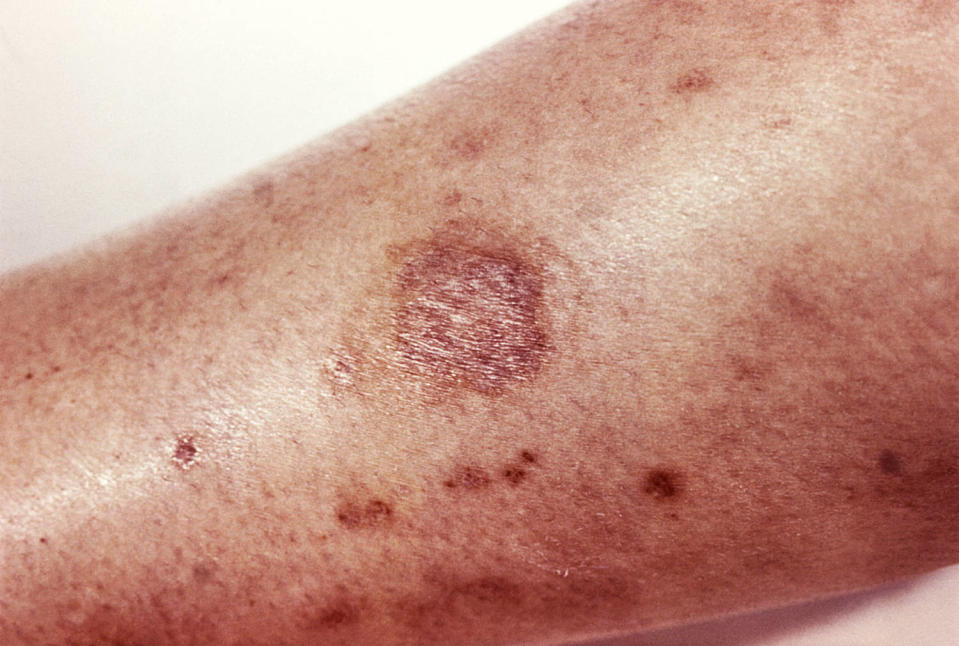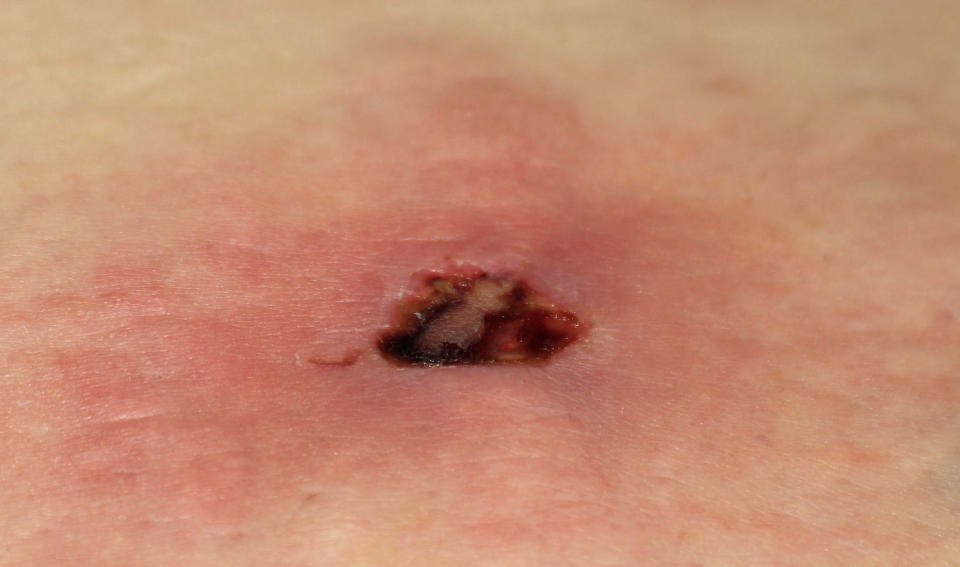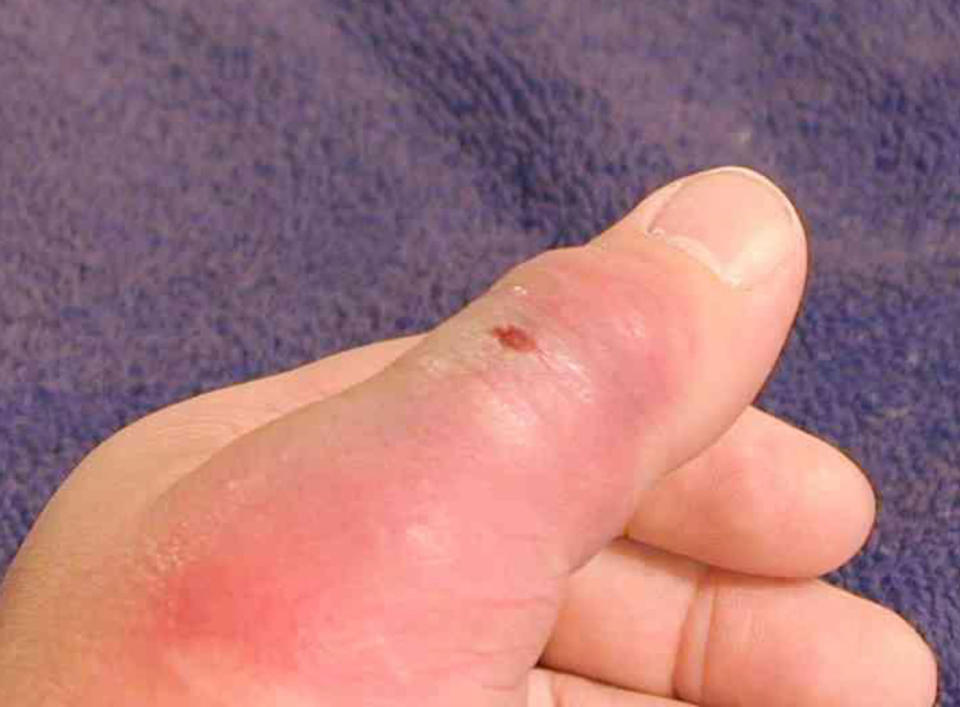What do spider bites look like? Know these important warning signs
Is your bug bite is actually a spider bite? It's not always easy to tell. And while most spiders can't bite humans, it's important to be on the lookout for certain spider bite symptoms because they can be severe — in rare cases, even deadly.
"The truth is that most spiders are too small to bite us, including those adorable jumping spiders," Jody Gangloff-Kaufmann, Ph.D., an urban entomologist and coordinator with the New York State Integrated Pest Management community program at Cornell University, tells TODAY.com.
Some larger spider species, such as wolf spiders and fishing spiders, may become aggressive and bite humans when provoked. If you're bitten by one of these spiders, they might leave you with a noticeable raised and itchy bump for a few days, Gangloff-Kaufmann says. But it shouldn't cause a severe reaction.
The spider bites that experts really worry about are bites from venomous spiders, particularly black widows and brown recluse spiders. A bite from one of these types of spiders can cause severe symptoms.
If you're bitten by a venomous spider, you'll require prompt medical attention to treat the bite.
So, if your area of the country is home to venomous spiders, it’s crucial to know where those spiders live, what their bites look like and what to do when you recognize the signs of a spider bite. Below, find some spider bite pictures to help you identify what you're dealing with.
Brown recluse and black widow spiders
"The two types of venomous spiders that are really of medical concern are black widow spiders and brown recluse spiders," Gangloff-Kaufmann explains.
Black widow and brown recluse spider bites can cause more severe symptoms and, in rare cases, death, the Centers for Disease Control and Prevention say. If you're bitten by one of these spiders, you will need medical attention to treat the bite and its effects.
Black widow spiders are found primarily in the southern and western areas of the U.S., the CDC says. They tend to live around manmade structures, Gangloff-Kaufmann explains, like a shed, in the garage or underneath a bench.
Black widows are also known to live in outdoor toilets where flies gather, the CDC says. "The one person I know who was bitten by a black widow spider was using an outhouse," Gangloff-Kaufmann says.
Above all, "You just don't want to be sticking your hands into dark corners," she adds.
Black widows make irregular or asymmetric webs, Medline Plus says, and the spiders can bite people when humans bump into their webs. The spiders also typically stay within a few feet of ground level.
Keep in mind that not all black widow spiders are the sameThere are also few different "flavors" of black widow spiders, Gangloff-Kaufmann says, including brown widows, northern black widows and western black widows, all of which have a version of the classic red hourglass-shaped marking that can be pretty easily identified.
Meanwhile, you're more likely to find brown recluse spiders in the Midwest and southern U.S., the CDC notes. These spiders, the name suggests, can be reclusive, Gangloff-Kaufmann says. They tend to stick to secluded, dark areas, like within leaf litter or rock piles. If they go indoors, they might hide in closets, corners or shoes, the CDC says.
Spider bite pictures

Unless you manage to see the spider bite you, it may be challenging to figure out whether or not your bump is actually a spider bite.
When diagnosing what might be a spider bite, doctors look for specific signs on the skin and symptoms that can affect the entire, Dr. Melissa Levoska, an assistant professor of dermatology at the Icahn School of Medicine at Mount Sinai, tells TODAY.com.
These signs help doctors figure out which specific type of spider may have bitten you. Although both black widows and brown recluse spiders release venom when they bite, the two types of venom actually “work quite differently,” Gangloff-Kaufmann says.
Brown recluse venom only acts locally at the site of the bite, typically causing severe skin issues. The venom of a black widow spider, however, is a neurotoxin, the CDC says. Black widow venom causes widespread pain across an area of the body.

Bites from different spiders tend to feel different, too.
"Brown recluse spider bites tend to be painless, but black widow spider bites can be painful," she explains. "Brown recluse spider bites can get a blister," she adds, "and they can actually develop skin necrosis, which is kind of like skin cell death."
Brown recluse bites also may develop an area of dead skin tissue called an eschar that eventually sloughs off and leaves an ulcer behind, Levoska says. But black widow bites don’t usually do that.

The first signs of a black widow spider bite are usually a pinprick sensation, minor swelling, redness and a target-shaped sore, Medline Plus explains. Within 15 minutes to an hour, people may start to experience dull pain in a large area of their body, which may be in a different place depending on where they were bitten.
When a brown recluse spider bites, you may or may not feel an immediate sharp sting, Medline Plus says. After that, pain and other symptoms tend to develop over the next few hours.
If you're not sure what caused the bite or rash and you start to develop worrying symptoms, it's a good idea to get checked out just in case. Keep in mind that your bite could also look like a wasp sting or even a rash from coming into contact with plants (like nettles) outside, Gangloff-Kaufmann says.
Spider bite symptoms and warning signs
In addition to the bite itself, you might develop some other symptoms in the next few hours and days.
The early signs of a spider bite may include:
A raised, itchy bump or rash
Pain at the site of the bite
A red or purplish area of skin around the bite
Sometimes, two noticeable fang puncture marks
Blistering at the site of the bite
According to the CDC, other symptoms of a venomous spider bite can include:
Muscle aches or pain
Headache
Nausea
Vomiting
Increased sweating
Difficulty breathing
Fever
Chills
Anxiety or restlessness
High blood pressure
How to treat a spider bite
A spider bite on its own isn't necessarily a cause for concern.
"Most spider bites are going to be just an itchy rash, maybe some blistering and swelling at the site, and they don't even report to the doctor," Levoska says. "Most people will just manage these bites at home."
But you should seek prompt medical attention if you notice any other symptoms, particularly the above symptoms that affect the rest of your body, like widespread pain, fever or nausea, the experts say. Those are signs that you were bitten by a venomous spider, which means you'll require medical treatment.
If you know for sure that you were bitten by a venomous spider, you should get medical attention. Anyone who's concerned about a spider bite to call poison control or 911 for first aid guidance and further instructions, Medline Plus advises.
Treatment at the hospital for a spider bite might include antivenom, antibiotics, pain medication and wound care, depending on the type of spider responsible for the bite, MedlinePlus says. With prompt treatment, severe symptoms tend to improve within a few days while other milder symptoms may linger for weeks.
This article was originally published on TODAY.com

